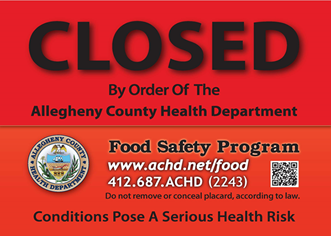Food Safety

New Citizen Access Portal
To pay a food permit renewal, submit a permit application, or register for the Food Protection Manager Course/Exam, create an account on the Citizens Access Portal. Create an account to begin(PDF, 377KB).
File a Complaint
The Food Safety Program inspects food operations in Allegheny County that make, distribute, or sell food products. These food operations are called “food facilities”.
Required inspections are done by Environmental Health Specialists, or Food Inspectors. Inspectors visit food facilities without warning and check whether the food facility is following Allegheny County's Food Safety Rules and Regulations (Article III).
Inspections are done twice a year, every year, or every other year depending on what types of food a facility prepares and their past inspection history. A food facility that serves a wide range of foods or uses complex methods to prepare foods might be inspected more often than a food facility with a smaller menu or that only serves commercially-packaged foods. A food facility whose history shows a pattern of high or medium risk violations may be inspected more often than a food facility whose inspection history shows fewer concerns.
It's important to remember that while the observations made during the inspection are a good approximation of a facility's overall sanitary condition, they are unique to the day. Inspections essentially act like a "snapshot", giving a small piece of the overall picture of a facility's operation.
Inspections are meant to find conditions that may put people’s health in danger. These conditions are cited as violations, and the food facility is required to fix the problems listed on the report. There are three different types of violations: high, medium, and low-risk violations.
Types of Violations
High-Risk violations are dangers (hazards) that may lead directly to food-borne illness or injury, and where there is no other way to guard against the risk. These hazards must be fixed immediately; or the inspector and person-in-charge at the food facility must find a way to make a short-term change until a long-term, more permanent solution is completed. A follow-up inspection, or reinspection, may be required. Some examples of high-risk violations are:
- Holding food at the wrong temperature (e.g. not keeping foods cold enough)
- Poor food worker hygiene (e.g. the cook does not wash his or her hands)
- Improper cooking practices (e.g. the food is not being cooked to adequate temperatures)
Medium-Risk violations are dangers (hazards) that may add to the risk of food-borne illness or injury. When corrected, these conditions help reduce or stop high-risk hazards. Medium risk hazards may need to be fixed during the inspection or require a follow-up inspection. Some examples are:
- Inadequate hand washing facilities (e.g. the hand sinks do not have soap)
- Lack of a food probe thermometer (e.g. no means of monitoring food temperatures)
- Lack of a Certified Food Protection Manager (e.g. no one at the facility being certified as having knowledge of safe food handling practices)
Low-Risk violations may not directly cause food-borne illness but controlling these violations helps create safe conditions and prevent high and medium risk violations from happening. Low risk violations relate to general sanitation, food safety systems, sanitation standard operating procedures (SSOPs), building structures, equipment design, general maintenance, or administrative requirements. These violations may not require immediate correction but may require a follow-up inspection. Some examples are:
- Broken and cracked floors (may provide insects a place to live)
- Failure to clean and maintain ventilation hood systems (may lead to an increased fire risk)
- Poor lighting (employees may not be able to see enough to make sure the facility has been cleaned correctly)
If a food facility does not fix violations, the Food Safety Program may seek administrative intervention or enforcement, such as alerts, closures, or civil penalties (fines), depending on how severe the conditions are and how long the food facility has allowed the unsafe conditions to happen.
The Food Safety Program provides each permitted food facility in Allegheny County with a placard at the food facility entrance. This placard, which must be displayed, lets consumers know what the current inspection status of that food facility is.
Green Placard: Inspected and Permitted
A green “Inspected & Permitted” placard signifies that a food facility has met the minimum food safety standards.

Yellow Placard: Consumer Alert
A yellow “Consumer Alert” placard signifies that food facility is out of compliance with minimum food safety standards and the conditions may pose a risk to public health.

Red Placard: Closed
A red “Closed” placard signifies that a food facility has been ordered to close and is not permitted to serve food to the public.
